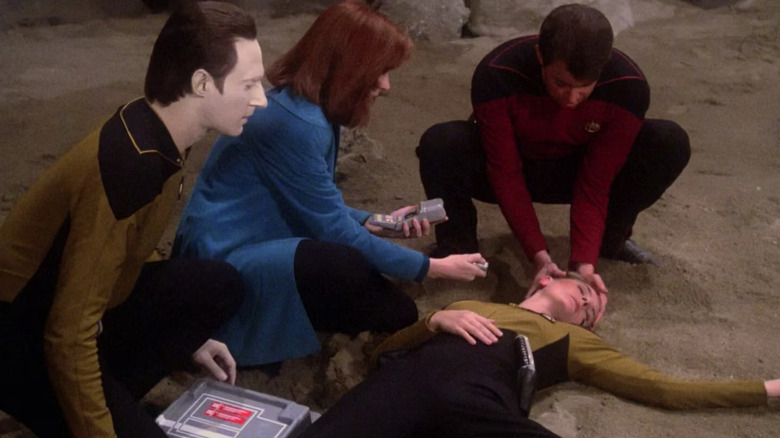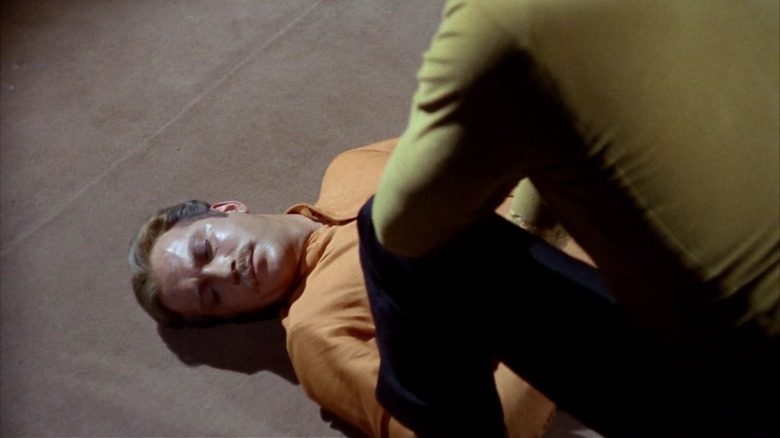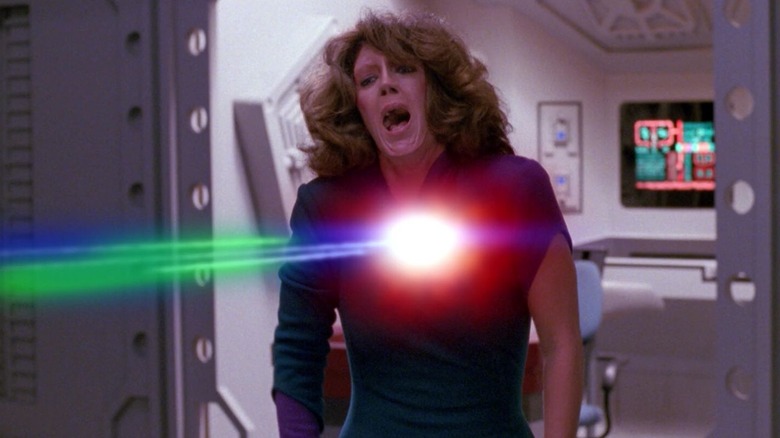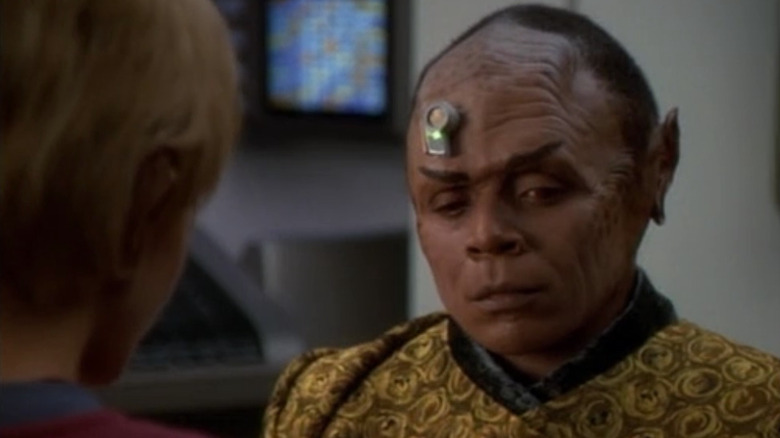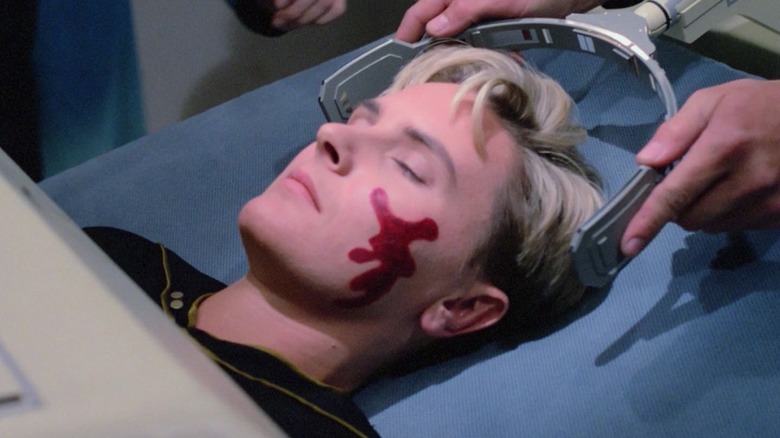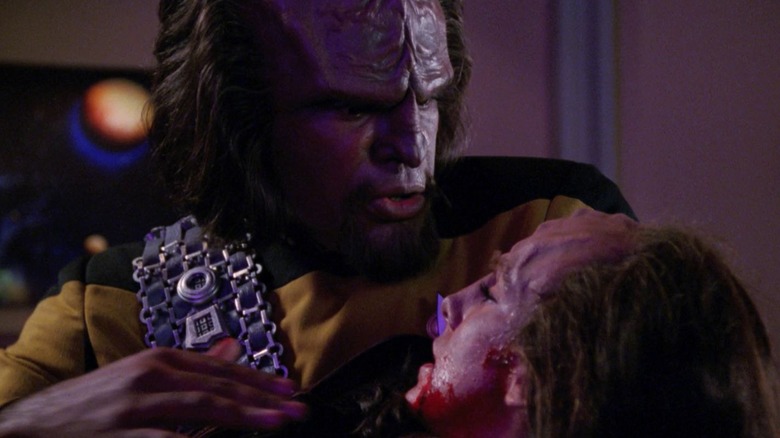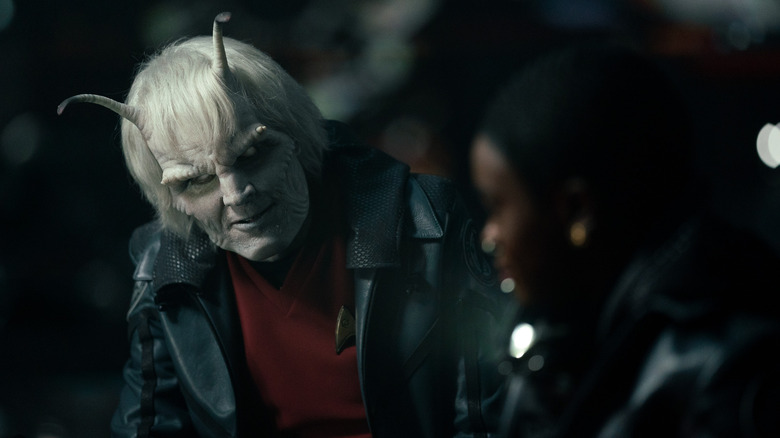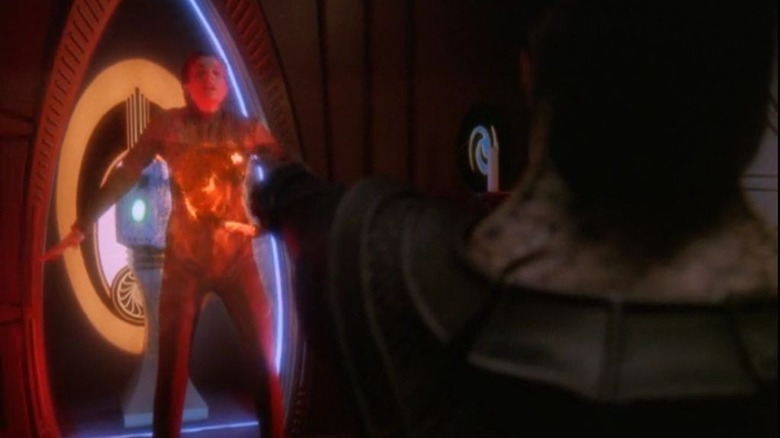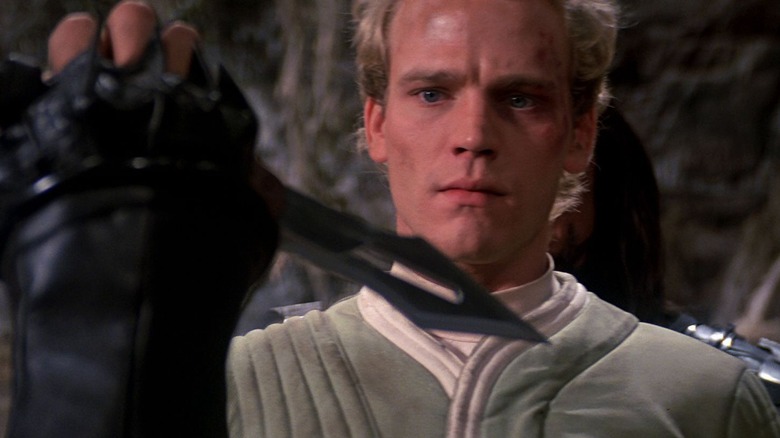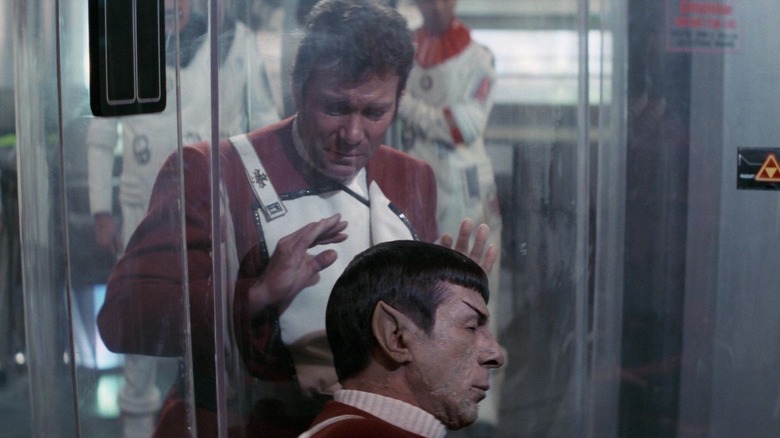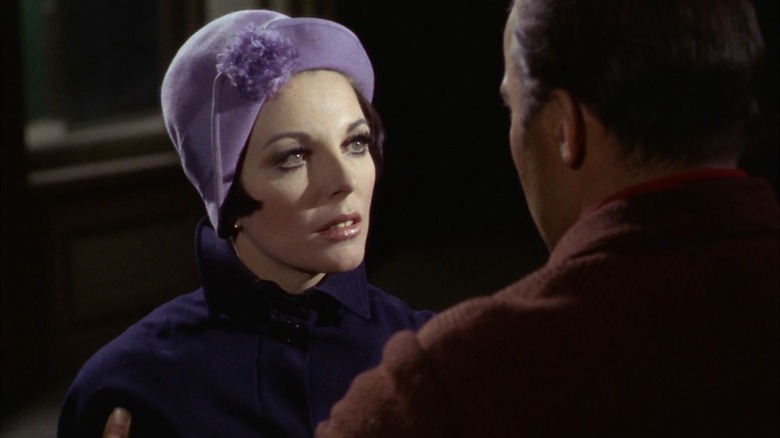Star Trek: The 10 Saddest Deaths In The Franchise, Ranked
Although it became something of a pop culture catchphrase, Dr. McCoy (DeForest Kelley) only said "He's dead, Jim" four times throughout "Star Trek." He does say variants like merely "He's dead" or "He's dead, captain" a few times, however. This is all to point out that people die frequently on "Star Trek," as being a Starfleet officer is a dangerous job. One cannot serve on the Federation flagship without encountering life-threatening danger on a weekly basis.
Indeed, many Trekkies became flippant about the deaths on "Star Trek" to the point of finding them a little risible. The word "redshirt" — a slang term for a doomed, nameless pawn — entered the lexicon when Trekkies noticed how often supporting players, usually in red uniforms, bit the big one under the command of Captain Kirk (William Shatner). McCoy may have only said "He's dead, Jim" four times, but 24 redshirts died on his watch.
It wasn't until a notable character death in "Star Trek II: The Wrath of Khan" that "Star Trek" started to become a little more ginger about killing off its Starfleet officers. The showrunners realized that character deaths would be more meaningful, tragic, heroic, and memorable if they weren't common. By the time "Star Trek: The Next Generation" came along in 1987, the wholesale slaughter of uniformed officers shrank considerably.
It did still happen, though. Indeed, many of the deaths on "Star Trek" are downright terrifying and tragic, whether they be large and dramatic or sudden and unexpected. Below is a list of the 10 saddest character deaths in the history of the franchise. It may or may not include the notable "Star Trek II" death mentioned above.
10. Sam Kirk in Operation -- Annihilate!
In the original series episode "Operation — Annihilate!" (April 13, 1967), the U.S.S. Enterprise is visiting a colony on Deneva to visit Kirk's brother Sam. They find that a swarm of flying, bacon-like parasites have infected the colony, adhering to their victims and altering their brains. It is said that the parasites' influence is excruciatingly painful, and that Sam suffered significantly before succumbing.
While James Kirk is certainly saddened by the death of his brother, it's not terribly sad for the audience since we didn't even know Kirk had a brother until the events of "Operation — Annihilate!" Sam's death has, however, become far more tragic in recent years, as the new series "Star Trek: Strange New Worlds," set before the events of the original "Star Trek," allowed audiences to meet Sam for the first time. In "Strange New Worlds," Sam is played by Dan Jeannotte and he serves on board the U.S.S. Enterprise under Captain Pike. James Kirk (Paul Wesley) occasionally stops by, and the two brothers snipe at each other in that resentful-but-loving way that brothers do. We now see that the characters have warmth and familial camaraderie that Trekkies never saw in the original series.
And then, all of a sudden, we remember "Operation" and feel very sad. Sam may be an affable, friendly man, but we know he is destined to perish, killed by malevolent space bacon. That's terrible.
9. Varria in The Most Toys
In "The Most Toys" (May 5, 1990), the android Data (Brent Spiner) is kidnapped by a soulless collector of trinkets named Kivas Fajo (Saul Rubinek). Fajo may be one of the wickedest villains in "Star Trek" history, as he has come to worship meaningless acquisition as his primary raison d'être. In the post-capitalist utopia of "Star Trek," mindless collection of rare items is the worst possible philosophy. The scientists of "Star Trek" would happily display rare items in a museum where the public would have free educational access to them, but Fajo seeks to keep his items hidden, shown only to other collectors. Data, whom Fajo sees as a thing, is his latest trinket.
Fajo also lost his conscience somewhere along the way and thinks nothing of threatening the life of Varria (Jane Daly), a woman he has been raising/abusing since she was an adolescent. When Data refuses to comply with Fajo's demands, he points a weapon at Varria, explaining that this particular weapon melts you from the inside out. It's very rare, and provides one of the most painful deaths an energy weapon can provide.
Later in the episode, Varria, fed up with Fajo's threats, helps Data escape. Fajo gets the drop on them and skittishly fires his weapon, killing Varria. She wails in agony for several seconds before being vaporized entirely. She was a victim her whole life and died in a terrible, painful way. Data, ordinarily emotionless, seems to have been overwhelmed by the injustice of Varria's death, and seemingly moves to kill Fajo. Data, for the first time, seems to have felt murderous wrath.
8. Tuvix in Tuvix
In the "Star Trek: Voyager" episode "Tuvix" (May 6, 1996), a transporter malfunction accidentally fuses security chief Tuvok (Tim Russ) and the jolly hobbit chef Neelix (Ethan Phillips) into a composite being with the personality of both. This new being calls themself Tuvix (Tom Wright) and sees no reason why he should not be allowed to rejoin the crew. With the memories of two beings, Tuvix seems to be perfectly capable. Indeed, Tuvix soon finds that he prefers being a composite being rather than two individuals.
Captain Janeway (Kate Mulgrew), however, is told by her engineering team that they can put Tuvix back on the transporter pad and re-separate Tuvok and Neelix — a turn of events that chills Tuvix to the core. To restore the two dead crew members, Tuvix will essentially have to sacrifice his life.
In a widely debated decision, Janeway orders Tuvix to give up his life to restore the status quo. Tuvix wails and protests, screaming that what Janeway wants it wrong. Tuvok and Neelix are essentially dead, as far as anyone is concerned. Tuvix is not evil, he's not deteriorating, and he's not a threat. He's an innocent individual. Janeway still orders that he be obliterated. It's Tuvix's protests that make his death particularly tragic.
7. Tasha Yar in Skin of Evil
The most shocking thing about the death of Tasha Yar (Denise Crosby) is how random it was. In the "Star Trek: The Next Generation" episode "Skin of Evil" (April 25, 1998), an away team has beamed down to a seemingly inhabited planet to rescue the people on board a crashed shuttlecraft, only to find that a sentient mass of black tar stands in their way. The tar, calling itself Armus (Mart McChesney, voice of Ron Gans), explains that it is comprised of all the negative emotions of a long-departed species, scientifically cut free and deposited on this planet to languish alone. It feels nothing but hate and cruelty, and is armed with a raft of psychic superpowers.
When security chief Yar tries walking around Armus, it lashes out with a beam of energy, throwing her through the air and killing her. This was not a noble death; Yar was killed like any redshirt, murdered by a superbeing as a demonstration of its power. Her death doesn't even provide the other Enterprise crew members with new information that helps them. She's just dead. Sure, Starfleet is a dangerous job, but it was harsh how little ceremony was employed in Yar's murder.
Crosby infamously wanted off "Star Trek" as she didn't like standing in the background while other, more interesting characters got all the dialogue, so Yar was removed entirely by producer Rick Berman. Crobsy eventually returned for several episodes, including a few alternate timeline stories, as Yar's half-Romulan daughter Sela. But, wow, it was a surprise to see Yar die so abruptly.
6. K'Ehleyr in Reunion
K'Ehleyr (Suzie Plakson) only appeared in two episodes of "Star Trek: The Next Generation," but she was a standout. She was flippant, confident, smirking, and wry. Even a little sassy. She was a powerful half-human, half-Klingon ambassador, wearied by the political nonsense that the Klingon Empire was currently dealing with. While on the Enterprise, she and Worf (Michael Dorn) bond and end up having violent Klingon sex. In "Reunion," the two are reunited, with K'Ehleyr presenting Worf with a young son, Alexander (Jon Paul Steuer). K'Ehleyr hid Alexander from Worf as she knew him to be honorable and suspected he would propose marriage. As a professional diplomat, she very much didn't want to be married.
Sadly, the machinations of "Reunion" put K'Ehleyr in the crosshairs of the assassin Duras (Patrick Massett). Worf watched her die and then killed Duras as revenge. The circumstances of K'Ehleyr's death are tragic, but more so, audiences lost out on more opportunities to spend time with such an awesome, funny character played by such a forthright actor.
Plakson returned to "Star Trek" playing a Q on "Star Trek: Voyager," so Trekkies weren't entirely deprived. But, golly, we all wish we could have had more time with her.
5. Hemmer in All Those Who Wander
In the "Star Trek: Strange New Worlds" episode "All Those Who Wander" (June 30, 2022), the U.S.S. Enterprise investigates the disappearance of the U.S.S. Peregrine, a ship that recently crash-landed on an uninhabited ice world. When the crew beams down to see what happened, they find themselves, essentially, in the middle of Ridley Scott's 1979 film "Alien." The ship has been ripped apart and its crew is dead. It seems that the Gorn, an evil race of aggressive reptiles, attacked the downed ship and implanted several people with their eggs. Just like in "Alien," the Gorn incubate their young inside the abdomens of unsuspecting hosts and the babies are "born" when they rip their way out from inside. "All Those Who Wander" even features a stone-faced young girl, very reminiscent of Newt (Carrie Henn) from James Cameron's "Aliens."
During the kerfuffle, the grumpy engineer Hemmer (Bruce Horak) becomes implanted with Gorn eggs. Because they are in a desperate fight-for-your-life scenario, there is no way to extract the eggs and save Hemmer's life, so he decides to throw himself off of a cliff, killing the monsters inside of him. Hemmer is an Aenar and hails from an icy planet, so the snowy locale is like paradise for him. As he dies, he comments that he feels like he's coming home.
Hemmer was an excellent character, serving as a cynical counterpoint to his assertively upbeat counterparts; fans loved him. Also, actor Bruce Horak is blind, and it's rare that blind actors appear in mainstream genre entertainment like this. Seeing both the character and the actor be removed from "Strange New Worlds" hurt a lot.
4. Jadzia Dax in Tears of the Prophets
In the final episode of the sixth season of "Star Trek: Deep Space Nine," called "Tears of the Prophets" (June 15, 1998), the already evil Gul Dukat (Marc Alaimo) has communed with mysterious noncorporeal entities called Pah Wraiths that seek destruction and can take possession of people's bodies. They're the "Star Trek" equivalent of demons. A Pah Wraith takes possession of Dukat and he charges to a local Bajoran temple, hoping to gain access to a sacred magical Orb that rests inside. Jadzia Dax (Terry Farrell) happens to be exiting the temple when he arrives and the possessed Dukat blasts her in the chest with some sort of demonic energy bolt. She falls down dead.
This was shocking, as Dax had been a regular character since "Deep Space Nine" premiered in 1993. Initially, she was a wizened character, carrying around a centuries-old symbiont in her body that had the memories of seven previous lives. By the show's sixth season, she had grown into a much more active, dynamic character, fond of gambling with Ferengis and sparring with Klingons. She had only recently married Worf (Michael Dorn) and they were discussing having children. To see Jadzia so boldly removed from the series hurt many Trekkies. It seemed so random.
Of course, learning about what was happening behind the scenes makes the death even worse. Farrell was tiring of the long, long shooting schedules and asked producer Rick Berman that her role be reduced to a recurring character. Berman refused, saying that she could either stay on full-time or be written out entirely. Farrell didn't want her character to die, but she had to agree.
The Dax symbiont persisted in the body of Canadian actor Nicole DeBoer, but how tragic that Farrell was so brusquely removed.
3. David Marcus in Star Trek III: The Search for Spock
Leonard Nimoy's "Star Trek III: The Search for Spock" is a rare animal in the "Star Trek" canon; it's a story wherein the characters behave entirely selfishly. Kirk is not on assignment and he has not been given a mission. He learns that his late companion, Spock (Nimoy), had shunted his consciousness into Dr. McCoy (DeForest Kelley) shortly before perishing in "Star Trek II: The Wrath of Khan." Meanwhile, many lightyears away, a quirk of the newly tested Genesis Wave re-grew Spock's body on the very spot where his corpse had been deposited. Kirk, acting on advice from Spock's father Sarek (Mark Lenard), figures he can bring Spock's consciousness, stored in McCoy's brain, and his newly regrown body back to Vulcan where psychic priests can reunite them, effectively resurrecting his friend.
To do this, however, Kirk has to hijack the Enterprise, shocking Starfleet. The Genesis Wave also attracted a violent Klingon named Kruge (Christopher Lloyd), who would kill anyone to get it.
Kirk is ill-prepared, unable to fend off a Klingon attack with only the senior staff on board. When the villains infiltrate the ship, Kirk has to blow it up. Then, when Kruge learns that the Genesis planet is being investigated by Kirk's son David (Merritt Butrick), he holds the man hostage. Kirk only learned he had an adult son in "Star Trek II" and the characters were only just coming to peace with their new relationship. When Kruge kills David, he takes another thing from Kirk. His friend was dead, his ship was destroyed, and his son was murdered. That's what you get for doing something selfish in "Star Trek."
2. Spock in Star Trek II: The Wrath of Khan
We weren't going to escape a "tragic deaths in 'Star Trek'" list without addressing the death of Spock in "Star Trek II: The Wrath of Khan." Throughout Nicholas Meyer's film, Kirk talked a big game about never wanting to fail. He even tells a story about how he cheated on a crucial test back at Starfleet Academy, a test that was designed to be a no-win scenario. But by "Star Trek II," Kirk was no longer a young buck, and his flippant attitudes weren't going to gain traction anymore.
Kirk learns that he had an adult son named David, who was hidden from Kirk by his mother, Dr. Marcus (Bibi Besch). He also finds that an old rival, Khan (Ricardo Montalbán), wants revenge after Kirk forgot about him and left him to rot on a deteriorating planet. Kirk's past was finally catching up to him. In order to outrun it, a sacrifice was required. During a starship battle between the Enterprise and a ship Khan hijacked, the former is damaged. The only way to fix the engines is for someone to enter a highly irradiated chamber and do the repairs by hand, killing themselves in the process. Spock takes care of it, saving the ship, but absorbing a lethal dose of radiation in the process. Kirk and Spock have a final moment together through glass before Spock succumbs.
To see one of the most important figures in "Star Trek" perish was a shock. And then, at Spock's funeral, everyone cried and Scotty played "Amazing Grace" on the bagpipes. There's not a dry eye in the house.
1. Edith Keeler in The City on the Edge of Forever
Easily the most tragic death in "Star Trek" came in the episode "The City on the Edge of Forever" (April 6, 1967) when Edith Keeler (Joan Collins) was run down by a car.
The conceit of "City" was that Dr. McCoy ran through a time portal while hopped up on drugs and did something in the past to make the U.S.S. Enterprise vanish. Kirk and Spock have to follow him through the same portal, arriving on Earth in the year 1930. It seems they arrived before McCoy, however, and they have to blend in with the locals for a spell. Kirk meets Edith, a gentle, wise pacifist who speaks out against the rising tide of fascism in Europe. Kirk falls in love with her immediately.
Of course Spock, using limited instruments, has learned that Edith's continued existence on Earth is tied directly — in a Butterfly Effect way — to the victory of the Third Reich. She is to die in a car crash. If she is rescued, as McCoy is destined to do, then the Nazis will win. Kirk has to stop McCoy from saving her and be present to watch her die. It breaks Kirk's heart, but more so, it's tragic that a powerful pacifist like Edith had to be punished to assure the war be stopped. Gene Roddenebrry was cynical about the survival of true pacifists. War takes lives, even before the fact.
Since "Star Trek" is about novel sci-fi solutions, it's a little baffling that Kirk didn't suggest taking Edith back to the future where she would be dead to history, but alive on the Enterprise. "The City on the Edge of Forever" is more of a "Twilight Zone" episode than a "Star Trek" episode. But it doesn't change the tragedy of Edith's fate.
